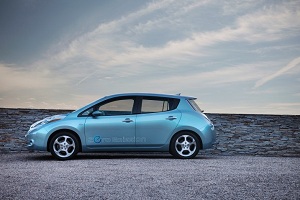Hawaii looking to EVs, renewables to cut oil dependency
 Perhaps no state in the country is more well-positioned or in greater need than Hawaii of turning its motorists onto electric vehicles while at the same time switching it’s grid over to renewable power sources like solar.
Perhaps no state in the country is more well-positioned or in greater need than Hawaii of turning its motorists onto electric vehicles while at the same time switching it’s grid over to renewable power sources like solar.
The island state relies on imported oil products for about 90 percent of its electricity generation right now, said Peter Rosegg, spokesman for Hawaii Electric. And the state has among the highest gas prices in the country, averaging over $4.25 a gallon, Rosegg said.
While Hawaii has nowhere near the population mass that would normally attract car manufacturers to include it among their early release markets, the state has enough passion to make up for it. There are already a number of electric cars on the island, and Hawaii Electric received its first Nissan Leaf a couple weeks ago, Rosegg said.
“We have a long history of interest in electric vehicles here,” Rosegg said. “It started in the last, I guess you would call it, boomlet in the 1990s.”
The state utility invested in a whole fleet of electric vehicles then and even had a plug-in electric bus that it used to transport employees between facilities.
“We kept using those electric vehicles until they literally couldn’t be driven anymore,” Rosegg said.
The island is working with Better Place to install infrastructure for electric vehicles and dealing closely with AeroVironment, the company installing home chargers for Leaf buyers.
Hawaii Electric has also created incentives to encourage its customers to buy electric vehicles and especially to charge them overnight when power demand is lowest.
The utility recently celebrated the groundbreaking of a new 30-megawatt wind farm that Rosegg said he hopes will be the first of several.
“The wind blows overnight,” he said. “And on a small island like this, there isn’t usually a lot of demand for power overnight. We want to add electric vehicles and we want to do it in such a way that we don’t add to the use of fossil fuels for electricity generation.”
Rosegg, who has been advocating for electric vehicles in Hawaii for several years, said that even if the utility did nothing to wean itself off fossil-fuel dependency and everyone on the island switched to electric vehicles, the state would still consume significantly less oil than it does now while using it for both power generation and transportation.
Hawaii, which has the highest solar generation ratio of kilowatts to residents in the country, boasts aggressive incentives for residential solar installations. Rosegg said he knows several people who have bought electric cars and added extra solar to their homes or garages in order to power their vehicles.
It makes more financial sense, he said, for a homeowner to power his car with that solar energy than it does to feed it back into the grid and take the payouts for the utility.
Looking forward, Rosegg can imagine the utility being capable of drawing power from the large collective battery that will be composed of the many electric vehicles on Hawaiian roads.
In the mean time, the utility knows it needs to prepare for EVs, Rosegg said. People of like minds and social status tend to cluster in neighborhoods, and Rosegg expects there to be enclaves with more EVs than others.
“If we have a bunch of electric vehicles in a neighborhood, that’s going to have an impact on the grid,” he said.



